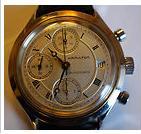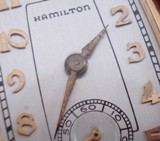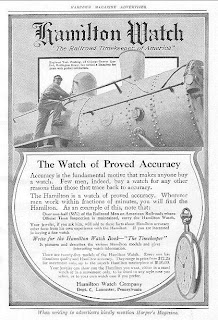by Tom Adelsten
When we talk about something’s value or worth, we really have three ways you can measure it:
- Market Value
- Income Value
- Value in Use
I’ve found most people want to discuss market value and rarely think about the others. Most of us want an appraisal and that’s tricky. If it’s for insurance purposes, a jewelry appraiser will overstate the cost of replacement. That’s actually fair within the context of insurance.
In commerce, fair market value (FMV) becomes the rule and that means negotiation or what a buyer is willing to pay and a seller is willing to take. When it comes to vintage Hamilton wristwatches, I find that we want to know FMV when we want to buy a gift, sell a watch for a quick dollar on eBay, trade or collect. Few people purchase vintage watches to wear every day. If the do want a vintage watch for everyday use, they should expect disappointment.
We don’t treat watches like people did in the past. In 1938, for example, you knew that your watch needed cleaning every three to six months. You would let it run down every night and wind it every morning. You did not unwittingly bang it against a wall. People took care of their watches, because they had no choice.
Collectors and beneficiaries look at Hamilton vintage watches with a notion of intrinsic value. I would never sell my grandfather’s Hamilton pocket watch or the one he wore on special occasions. I sold his Jaeger-LeCoultre Memovox as soon as I could. I didn’t connect him and that watch. I had fond memories of that 1938 solid gold Hamilton and it remained in my jewelry box.
Let’s think about FMV in terms of supply and demand
What’s happened to the supply of used watches referred to as vintage or antiques? Several different situations have affected the supply. I list these below. With the factors I mention in mind, I’m at a loss to explain why prices for Hamilton Vintage watches remain so low. It seems odd to me that when a commodity’s supply diminishes the price remains stable and doesn’t increase. That’s what has caused me to address the valuation issue.
Hamilton Pocket Watches
Vintage Hamilton Wristwatches
Sponsored Links
New collectors of Hamilton watches will find that a very high percentage of watches available on the Internet have come out of estates and garage sales. A backlog of old watches doesn’t exist, generally speaking. Several factors have dented the supply of older wristwatches.
Gold smelters in the 1970’s destroyed in excess 98% of all wind-up vintage watches. If you see a “production” figure of say 2000 units for a certain model, then maybe and I mean maybe, 20 of that model remain. They’ll be in various conditions from worn-out and not running to running and maybe in good shape.
My grandfather, uncles and father participated in this activity. They owned guild jewelry stores as far back as 1902. They sold many Rolex watches among others. If a customer came in for a newer watch, my folks would accept a trade-in of the customer’s old watch and toss it in a barrel. You read that correctly.
When the gold smelting began, they had employees haul those barrels to Southwest Smelting and had the gold leached out. My folks made a lot of money at that time. As a side note, they smelted their entire Christmas inventory when gold reached $60, then again when it went into the $400 range. That left nothing for their long time patrons.
Why did they do that to their customers? For what amounted to a small fortune. I understood it even though I didn’t agree.
People have and continue to buy many vintage watches for parts. It’s difficult to find parts for old watches and many watchmakers only know how to change parts. They don’t know how to fix parts.
Collectors and hobbyists have also grabbed up as many items as possible. In 2012, the available inventory from estates and antique malls has started to disappear. You’ll also see churning, which in this case means buying, selling and then buying back. We’re dealing with a fairly static supply of watches with swings in demand based on the economy.
The first sellers of vintage Hamilton watches on the Internet market typically had an inventory purchased at NWCCA chapter meetings. An efficient market for vintage watches didn’t exist with the exception of four national conventions each year. Once eBay got started, people were in a quandary of how much to ask and how much to bid. The early sellers didn’t value their watches high enough considering demand.
What’s that watch worth today?
Two years ago, I bought a 1938 wristwatch for $135 plus shipping. That was considerably higher than the same model in the same condition would have sold for in an auction. I checked with Fast Fix Jewelry and they wanted $395 plus parts to clean, oil and adjust the watch. They also wanted four months to turn it around. Price disparity? I decided to have the dial restored, which cost $45 including shipping back and forth.
In June 2013, I bought the same model for $45 and shipping was free. The watch was in mint condition. I ask myself how is that possible.
If I didn’t know how to work on the movement myself, I would have to add $400 to the purchase price. If I asked someone to buy, service and restore the dial my cost would have run approximately $585. That’s a decent estimate of the value for a working, restored 1938 Hamilton watch in 2010. Not today.
Gold Prices in the 1970’s
After the United States deregulated gold in 1971, the price increased markedly, briefly reaching more than $800 per troy ounce in 1980. From 1980 to 2007, the price has remained in the range of $320 to $460 per troy ounce. The rising prices of the 1970’s encouraged smelting of anything with gold in it. That meant “gold-filled” watch cases. Why? The gold filled on top of brass and it was significant in amount. Solid gold also laid over brass, but in higher quantities. A $20 used wristwatch became a $200 piece of gold in 1974. My grandfather’s jewelry stores would give a customer a trade in allowance of $5 when the buyer surrendered their old watch for a new one. Those watches went into a barrel and prior to 1971, like other Jewelers selling Bulova Accutrons, no one thought anything of it.
Then came the on-rush. A firm called Southwest Smelting had a process for leeching the gold out of those watches. The barrels full of watches made their way to downtown Dallas, Texas. Off went what we call vintage watches. Who knew? If I could look into the future, I would have held on to my “used” 1957 Chevy.
Unless you just want a real vintage watch (and many people do), then consider a new Hamilton watch. Make sure it has a mechanical movement. Otherwise, you’ll pay $450 -$750 and get a $30 quartz movement.
Let’s take a look at if the decades have been fair to Hamilton wristwatches:
If you bought a watch in 1938, for example, a $90 watch would have an impact on your purchasing power given your current circumstances. You’ll have to imagine going into a jewelry store in the mall, looking at a solid gold model and writing a check for it.
In later years, you could use a hypothetical example similarly.
 |
| Hamilton Chronometer |
You’ll need to look at some recent sales from eBay, to find a buyer-seller gauge for the value of your watch. Some prices, in my opinion, are not representative of a typical exchange, but that’s irrelevant. Hamilton wristwatches have not been a “good investment”.
If you want one, then buy it for its novelty. Some of my Hamilton wristwatches are exceptional. With the exception of the improvements made in sealing cases, the movements and cases are as good and in some cases better than watches costing ten times as much.
Now let’s consider things for which to look when consider a purchase
Does the movement run?
When was the last service?
Do you see any rust on the movement?
Does it have a popular caliber of movement, for example a Hamilton 987?
Are parts available?
How long does the watch run on one winding? – (Condition of the mainspring.)
 Case
Case
If gold-filled, has any of the gold rubbed off ? (Brassing)
How clean does the watch look?
 Is the crystal clear and minus scratches? (Look to see if replacement crystals are available.)
Is the crystal clear and minus scratches? (Look to see if replacement crystals are available.)
Does the face have more spots in one area than the others? (Probable leaking of the case seal.)
Does it come with a band and is it new? (You will discover that some watches like the Hamilton Cushion need very thin bands.)
Are the hands clean and without any rust?
Model
How popular is the watch? (For example, the Hamilton Martin is plentiful, which means an over-supply).
How detailed is the description? (Unless you are a restorer or know you models – you might be buying a $5 flea market special.)
Pricing and Value
Have you compared prices?
Is it a Buy It Now? (If so, it is more likely than not – overpriced and in worse condition than it appears in the photos.)
Does it have a high first bid? (Many buyers avoid high first bids, so you might be able to buy the watch cheaply at the last moment.)
Have you checked the seller’s ratings?
Did you first see it at the last minute and want to jump on it? (Don’t do that.)
Overall
Is the watch customized? (Has a seller changed the original appearance? For example, did someone have the dial painted colors the watch never came with? )
Has the seller given a date? (Ask where he or she got the information.)
Is the model name or number accurate and where did the seller find that information?
Research
Have you done a Google search and looked at the images on the browser tab?
Check out forums about the watch – you will find a great deal of information.
My advice is to know what you are doing and make sure the seller knows what he or she is doing. Chances are that they don’t. Try not to go with your gut feeling. Vintage watches are often fragile and don’t survive shipping. Add up to $300 plus parts to get it serviced.
Now let’s summarize:
1. The supply of Hamilton wristwatches have not gone up in market value even though the supply has almost disappeared.
2. Prices in 2014 are lower than most collectors would expect – myself included.
3. Value-in-use far exceeds any appreciation you will probably ever see in price.
4. Use a checklist to determine the condition of a vintage watch you’re considering for purchase.
What’s my opinion of Hamilton wristwatches?
I don’t even consider this a loaded question. Backing up from 21st century technology – I consider some Hamilton wristwatches as the best watches ever made. I don’t consider that self-serving.
I have bought, sold, serviced and restored a variety of vintage watch brands. The Hamilton 979, 987 series and the 989 movements are incredible. When working on them, everything fits.
One of the standards of watchmaking says that one should always (and I say always) attempt to save the original parts. I agree with the exception of the Hamilton movements I mentioned above for wristwatches and all of the Company’s pocket watches. I find it amazing that the Hamilton Watch Company never made a watch with less than 17 jewels. That makes an important difference to a watchmaker that only works on vintage watches.
Don Sauers in his book, Time for America, mentions an experiment where several watch manufacturers disassembled a number of their watches and put them in a container. Supposedly, the parts should interchange since everyone claimed they used the American Manufacturing System and their parts were standardized. Watchmakers could make a watch from random Hamilton parts, but could not with other makes or their models. That’s a performance and service issue.
Next, I look at the cases. Hamilton never made their own cases, but they gave case manufacturers specifications to high standards to meet. If the cases didn’t live up to standards, Hamilton didn’t use them.
I have yet to see another watch manufacturer’s cases hold their own when compared to a Hamilton. Hamilton cases have no equal, because they are made stronger, with more gold and fit tight. The tight fit keeps environment elements out of the cases.
When I consider style, I put myself in era when the watch was made. I look at furniture, architecture, automobiles, clothing, prices, the environment and read about life in that year. Hamilton styles were not only appropriate, but other watch companies copied Hamilton. Elgin, for example, offered watches that resembled Hamiltons the year after release. Hamilton didn’t copy other manufacturers. Instead the Company set the standards for the industry.
During the railroad days, Hamilton owned 56% of the market. That left 44% of the market for two dozen other companies to fight over. In the wristwatch business, Hamilton never went after market share. Instead, the Company went after quality. They owned the quality market.
Empirically speaking – Hamilton is the best of the vintage watches to own and collect. Then, there’s the subjective side. I love ’em.
One last piece of advice:
If you just want a quality retro-looking watch, visit the Hamilton Company web site. They’re also the best of the best. Especially when you want quality that you can afford. That sounds like an advertising slogan, but it wasn’t intended to be.
Copyright 2006-2017 | All Rights Reserved

